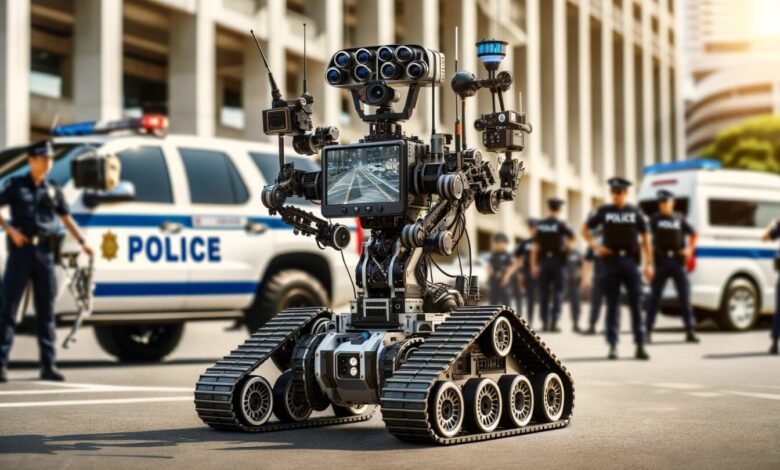How teleoperated robotics will change patrol response

This article is based on research conducted as a part of the CA POST Command College. It is a futures study of a particular emerging issue of relevance to law enforcement. Its purpose is not to predict the future; rather, to project a variety of possible scenarios useful for planning and action in anticipation of the emerging landscape facing policing organizations.
The article was created using the futures forecasting process of Command College and its outcomes. Managing the future means influencing it — creating, constraining and adapting to emerging trends and events in a way that optimizes the opportunities and minimizes the threats of relevance to the profession.
By Acting Captain John English
As Officer Michael Smith’s patrol car tears through the streets toward Lincoln High School, his radio crackles with urgent updates of an active shooter. Heart racing and hands clenching the wheel, Smith fights to steady his breathing, bracing for a potentially deadly encounter. His partner, a cutting-edge humanoid teleoperated robot, accompanies him in the passenger seat, providing a reassuring presence amid the chaos.
In the teleoperation room at the police department, Officer James Waters suits up with sensory gear and First Person View (FPV) goggles ready to assume control of the robotic officer. As Officer Smith screeches to a halt at the school entrance, Waters activates the robot through telepresence and the robot springs into action. Navigating through scattered debris and echoing screams, Waters maneuvres the robot with precision. He soon spots the gunman. Utilizing the robot’s superior technology, Waters skillfully disarms and restrains the suspect, all from a safe distance, paving the way for his team to secure the area. As the crisis de-escalates without further injuries, Smith watches the robot return to the patrol car.
The day’s events underscore the pivotal significance of teleoperated robotics in law enforcement, marking the emergence of what could be termed the Robot First Responder era. These advanced systems will soon revolutionize police response, offering enhanced effectiveness and heightened safety. As technology progresses rapidly, the Robot First Responder represents a transformative leap, promising to save lives and elevate the standard of police service in the community. Moving forward, it’s crucial to continue investing in and developing these technologies today to shape safer communities for our future.
| POPULAR: How robots are revolutionizing public safety
Understanding the need for teleoperation integration
Many communities in the United States face complex crime and social disorder challenges. Understaffed local law enforcement agencies struggle to keep up with population growth, leaving them overwhelmed and unable to meet demands.
Over the past decade, increased incidents of active shooters, terrorist attacks, suicidal individuals and assaults on officers have heightened public safety threats. These situations demand prompt responses but also endanger officers and communities. It is crucial for law enforcement to adopt new and innovative solutions to address these challenges. One solution is the integration of officer-directed teleoperated robotics, known as Robot First Responder.
Teleoperated robotics is the application of robots or robotic systems remotely controlled by a human operator. [1] Teleoperated robotics is going to empower officers to remotely control advanced robots equipped with cameras, sensors and haptic feedback technology, significantly enhancing officer safety without risking their lives. These robots will soon be deployed into mission-critical environments equipped with state-of-the-art sensors and technology. By minimizing direct physical interactions in potentially dangerous environments, this technology significantly reduces the risk of harm to officers and community members, creating a positive perception of safety.
Law enforcement can revolutionize safety and response by embracing teleoperated robotics as they come to market, making it crucial for agencies to act ahead of crisis. Although policing tends to lag in its adoption of new tech, it’s important to understand that it is already an accepted practice in other disciplines.
Changing our perspective
Teleoperated robotics has proven impactful in a variety of professional fields. One such example is in medicine. The leading robotic surgical platform known as the Da Vinci Surgical System is widely embraced across the globe, facilitating approximately 877,000 surgical procedures in 2017 alone. This innovative technology operates on the premise that it can enhance surgical outcomes by surmounting the inherent physical constraints of surgeons. [2] The United States military is another field looking into the adoption of a teleoperated robotic platform. The U.S. Army is considering the development of an unmanned ground vehicle (UGV) equipped with a 20-to-50-millimeter automatic cannon to support infantry and combat enemy armored personnel carriers, trucks and troops. [3]
We have seen how body-worn cameras and automated license plate readers, computer-aided dispatching, and the use of drone as first responder have enhanced police operations. A significant advantage of using teleoperated robotics in policing is their ability to handle hazardous materials or be the primary responder to dangerous and uncertain calls that require bomb investigation or disposal.
Teleoperated robotics can be equipped with specialized tools and sensors to detect and handle hazardous materials with precision and efficiency. They can also be used for other tasks such as surveillance, crisis negotiations, crowd control, search and rescue operations, or even be used as a public relations tool to engage with the community at various community engagement events. It is critical to understand that robotics in policing will complement human officers rather than replace them, making their integration transformative. While robots have advantages, they still require human judgment and communication skills to balance officer safety, civil liberties and potential risks. [4]
Companies like Tesla and Boston Dynamics are at the forefront of robotics. Tesla has manufactured Optimus, a humanoid robot designed for physical tasks, which boasts human-like capabilities such as walking, balancing and object manipulation, leveraging Tesla’s vehicle technology. Optimus will use advanced language processing to seamlessly communicate with humans, understanding intent even without explicit verbal cues. [5]
Boston Dynamics is another industry leader who has developed a similar robotic entity called Atlas, a humanoid robot designed to have enhanced mobility and manipulation capabilities. Atlas prioritizes efficiency and performance, enabling it to surpass human limitations in movement. This approach allows Atlas to excel in various tasks that could place human lives at risk. [6]
Optimus and Atlas are only two examples of robotic entities that could evolve and integrate into a system specifically for police deployment.
One of the most well-known programs in law enforcement today that is based on teleoperations is Drone as Frist Responder (DFR). Chief Roxana Kennedy of the Chula Vista (California) Police Department (CVPD) pioneered the groundbreaking “Drone as First Responder” (DFR) program. With the help of teleoperations and drones, CVPD quickly and efficiently responds to emergency calls for service. DFR gathers real-time information and provides tactical intelligence to officers before their arrival on the scene. Equipped with high-definition cameras, the drones stream video to a real-time operations center, where teleoperators can remotely control them and communicate with field units.
According to CVPD’s website, the DFR has responded to over 19,524 calls for service and assisted in the arrest of 2,742 suspects. The DFR’s average response time to calls for service (first on scene) was 92.76 seconds, while the average response time for all calls for service averaged 109.90 seconds. This is impressive, especially given that the City of Chula Vista covers 52 square miles. These achievements have also enabled CVPD to meet its priority one threshold limits, which had not been achieved in years. Teleoperations has allowed CVPD to provide a greater level of service to its community. By implementing DFR, public safety is improved, peacekeeping efforts are promoted, response times are minimized, and the overall quality of life in Chula Vista is enhanced. [7]
Chula Vista is only one example of the increased effectiveness and cost savings of teleoperated robotics. Though the initial investment in teleoperated robotics may be high, it can lead to long-term cost savings by reducing expenses from injuries and lawsuits in high-risk situations.
Police1’s VISION platform empowers police departments to navigate the complexities of the digital age
Implementing teleoperated robotics
To successfully implement teleoperated robotics in law enforcement, it is important to prioritize stakeholder engagement, transparency, funding and accountability.
First, transparency in decision-making is essential and a cornerstone for agencies to provide clear information on the objectives, capabilities, and limitations of teleoperated robotics. Open community forums should be organized to allow community members to express their concerns and feedback, which enables agencies to address apprehensions and build support. Based on research, the perception of communication robots in law enforcement was positive. A study examined the public’s perception of communication robots in law enforcement and the ethical considerations surrounding their use. The study found that the public positively perceived these robots, seeing them as valuable tools for enhancing law enforcement operations. [8]
Second, the need for stakeholder engagement shows participants believed that communication robots can improve efficiency, facilitate better communication and contribute to safer interactions between law enforcement and the public. [8] Law enforcement agencies should understand that with demonstrations and dialogue, support can be gained despite apprehension as these programs are built.
Third, to meet the need for accountability, departments should consider developing interactive dashboards and building agency websites to showcase their programs. These websites should include all program aspects, including statistics, equipment, policy, procedural guidelines, and use cases. Departments should also provide and plan to showcase how teleoperated robotics work by providing live demonstrations, allowing their respective communities and the media to see the usefulness and deployment of such technology. By providing accurate data to the community, there is less likelihood of adverse opinions.
Finally, we must look at sustainability of funding of teleoperated robotic programs. Agencies should seek resources from their respective community and state leadership. Federal government funding and private foundation support would be essential. To navigate ethical and legal considerations, agencies should assess the implications on privacy and civil liberties and develop comprehensive guidelines to mitigate risks and ensure accountability. Law enforcement leaders must communicate with their legislative representatives to create sensible laws regarding using and integrating teleoperated robotics in law enforcement applications. The utilization of teleoperated robotics is a rapidly evolving technology that has been making significant strides in various fields, such as the medical industry, military, and space exploration. [9]
Future challenges and implications
- By involving the community and stakeholders in the conversation, law enforcement agencies can ensure that integrating teleoperated robotics is a collaborative effort that benefits everyone. Addressing these issues proactively means agencies can enhance service to respective communities, establish a positive perception of public safety, and improve community relations. As they do, there are six primary challenges to address to ensure success:Agencies must overcome significant logistical and financial challenges to utilize teleoperated robotics in law enforcement. This requires a substantial investment in technology infrastructure to ensure law enforcement agencies have the necessary resources. The use of teleoperated robotics in law enforcement has the potential to improve law enforcement practices. The global market for law enforcement robots is expected to grow by $5.49 billion from 2024-2028. [10]
- Deploying agencies must establish comprehensive and thorough teleoperation training programs to equip officers with the skills needed for safe and efficient operation. These programs should cover various topics, including the operation and maintenance of teleoperation equipment, managing potential technical issues, and the appropriate response to emergencies. The training should include hands-on training sessions and simulations to provide officers with practical experience and develop their ability to handle unexpected situations.
- Law enforcement and policymakers must develop ethical legislation for teleoperated robotics. Comprehensive protocols and guidelines are needed to regulate their use, considering transparency, fairness and human rights. Proactive discussions with stakeholders are essential to ensure responsible deployment. [11] Legislation should protect civil liberties while promoting the responsible use of advanced technology in law enforcement.
- An important issue is addressing crimes committed via teleoperation. Are the legal consequences the same as for other crimes? How would law enforcement handle crimes committed with teleoperated robotics where the criminal is not physically present? Establishing legal protocols and a consensus on jurisprudence across jurisdictions is crucial for community safety and effective implementation. [12]
- Legal considerations for teleoperated robotics and their use of force must be addressed. Are the legal requirements for this technology the same as for humans? This is crucial. Would a stricter standard apply? Currently, the court uses the “reasonableness” standard from Graham v. Connor (1989), assessing force from a reasonable officer’s perspective, considering the need for quick decisions. Courts must establish clear directives before integrating teleoperated robotics to avoid harmful consequences and public fear.
- Law enforcement should partner with industry leaders to access cutting-edge technology used in other fields. Teleoperated robotics can revolutionize policing by acting as first responders in dangerous situations, such as active shooter incidents or hostage scenarios, significantly reducing the risks to human officers. These robots can effectively handle unpredictable and rapidly changing situations. [13]
Teleoperation is the future
While the idea of teleoperated robotics may seem like a concept from a science-fiction movie, it is already being used on a smaller scale with programs like the innovative design created by the Chula Vista Police Department’s Drone as First Responder initiative. Teleoperation programs have shown clear benefits, which opens the door for the next evolutionary step in law enforcement technology. Teleoperated robotics is a significant advancement in technology that can offer a higher level of service to communities. As technology continues to advance, the integration of systems like Robot as First Responder will cause a fundamental transformation in policing. This change will not only enhance the capabilities of law enforcement but also significantly improve the community’s overall perception of safety.
References
1. Shin M, et al. (February 1, 2021.) Enhancement of Perceived Body Ownership in Virtual Reality-Based Teleoperation May Backfire in Execution of High-risk tasks. Science Direct.
2. Pelican H, et al. (2018.) Operating at a Distance – How a Teleoperated Surgical Robot Reconfigures Teamwork in the Operating Room. Proceedings of the ACM on Human-Computer Interaction, 2(CSCW).
3. Keller J. (2019.) UNCREWED Army set to approach industry for prototype unmanned robotic teleop combat vehicle with automatic cannon. Military Aerospace Electronic.
4. Science Robots Science. (March 4, 2023.) Exploring the Type, Benefits, & Uses of Police Robots in Law Enforcement. Robots Science.
5. Biba J. (April 4, 2024.) The Tesla Robot: Here’s What We Know. Builtin.com.
6. Boston Dynamics. (2024.) An Electric New Era for Atlas. Boston Dynamics.
7. Drone Program. (n.d.). Drone Program City of Chula Vista.
8. Salehzaeh R, et al. (September 21, 2022.). Public Perception, Privacy, Safety, and Ethical Considerations of Communication Robots in Law Enforcement. ResearchGate.
9. Gottlieb J, Anderson D. (2011.) Teleoperated Robots. The MINDPROJECT.
10. PR Newswire. Security and Law Enforcement Robots Market size is set to grow by USD 5.49 billion from 2024-2028, Easy availability of electronic components boost the market.
11. Greeling K. (2013.) Autonomous Robots in Law Enforcement: Future Legal and Ethical Issues. Master’s thesis, Southern Illinois University Carbondale.
12. Asaro PM. (2011.) Remote-Control Crimes. Robotics & Automation, 68-71.
13. Nguyen HG, Bott JP. (November 1, 2022.) Robotics for Law Enforcement: Beyond Explosive Ordnance Disposal. Office of Justice Programs.
About the author
Acting Captain John English began his career in law enforcement in 1999 as a police recruit with the Chula Vista Police Department. Acting Captain John English has held a variety of assignments and collateral duties throughout his career.
A/Captain John English’s expertise falls within patrol, investigations and police administration. During his 24-year career, A/Captain John English has held the following assignments: Patrol Officer, Gang Suppression Officer, Family Protection Unit Detective, Task Force Officer (Cross sworn with the Federal Bureau of Investigations), Background Investigator, Patrol Sergeant, Training Division Sergeant, Professional Standards Sergeant, Patrol Lieutenant, and Strategic Operations Lieutenant, which includes the management of the UAS and Drone as First Responder Program. A/Captain John English currently oversees the Community Engagement Division. A/Captain has also served the department in many vital collateral duty assignments. These include the Canine Program Manager, Crisis Negotiator, Crisis Negotiations Team Supervisor and Crisis Negotiations Team Commander.
A/Captain John English holds a Bachelor of Science in Applied Arts and Sciences Criminal Justice Administration from San Diego State University, completed the California POST Management Class in 2020 and holds an FAA Part 107 Drone Pilot License. He is a graduate of POST Command College Class 72 and has been recently accepted to the University of San Diego to complete the Master of Science in Law Enforcement & Public Safety Leadership. His dedication to his profession has been recognized with awards such as the Chula Vista Police Department Medal of Life Saving, John H. Glover Medal of Heroism and the American Legion Medal of Valor.
NEXT: AI’s role in redefining policing: A 10-year projection



